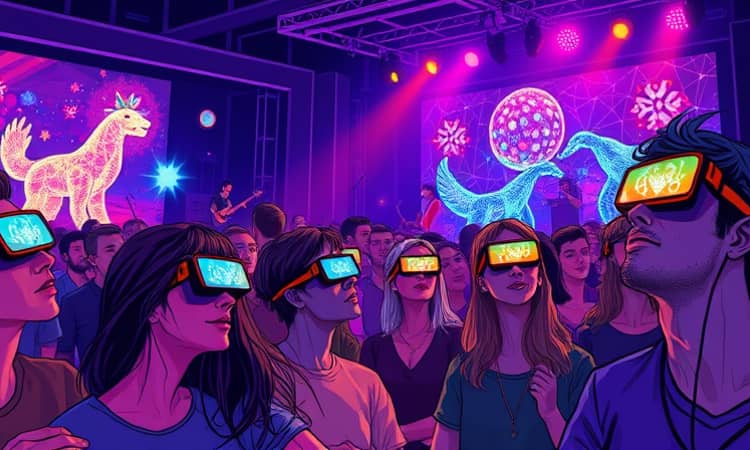Augmented Reality (AR) is redefining how we experience media, transforming passive observation into active participation. From gaming to live concerts and blockbuster films, this technology is poised to become a cornerstone of entertainment over the next decade, reshaping the way we connect with stories and each other.
Understanding Augmented Reality
Unlike Virtual Reality, which immerses users in fully digital environments, AR blends virtual elements with the real world. By overlaying contextual information on physical surroundings, it creates a hybrid experience that feels both familiar and astonishing.
Advances in computer vision, AI, and sensor technologies have fueled the rapid growth of AR platforms, making them more accessible and intuitive than ever before. As a result, developers and creators are exploring new ways to engage audiences across multiple entertainment verticals.
The Evolution of AR in Entertainment
AR’s journey in entertainment began with early mobile apps and simple overlays. Today, it has matured into a multifaceted ecosystem, powering blockbuster games, immersive theater, and interactive films.
The mobile AR market alone is projected to exceed $39.81 billion by 2027, driven by the widespread adoption of smartphones. Meanwhile, AR headsets and smart glasses are gradually gaining traction, promising deeper immersion and hands-free interaction. These trends highlight an industry on the cusp of exponential growth.
Early adopters in marketing tested simple AR filters and social media lenses, paving the way for more ambitious implementations. Today’s high-profile collaborations between technology companies and creative studios signal that AR has moved from novelty to strategic investment, with budgets scaling alongside audience expectations.
Interactive Gaming: A Paradigm Shift
AR gaming exploded into public consciousness with Pokémon GO, demonstrating the power of location-based, context-aware play. This phenomenon ignited mass adoption of AR experiences, inspiring developers to create titles that encourage exploration, collaboration, and real-world engagement.
Beyond viral sensations, AR gaming is evolving into new genres. Puzzle adventures, multiplayer battle arenas, and story-driven quests are now enriched with digital overlays that respond to environmental cues. Such innovations foster deeper emotional connections and encourage players to view their surroundings through a new, interactive lens.
Live Events and Concerts: New Dimensions
Concerts and festivals have embraced AR to captivate both on-site and remote audiences. From virtual pyrotechnics to custom camera angles, these digital enhancements elevate the sense of presence and participation.
Artists can now perform alongside holographic avatars or invite fans into augmented soundscapes, while remote viewers enjoy real-time effects that blend seamlessly with live footage. As AR gear becomes lighter and more affordable, expect to see even more boundary-pushing performances that defy traditional stage constraints.
Movies, TV, and Immersive Storytelling
Filmmakers and TV producers are experimenting with AR to create narrative experiences that transcend the screen. Imagine pointing a smartphone at a scene to uncover hidden plotlines or interacting with characters in real time. This level of engagement fosters unprecedented creative storytelling possibilities and deepens emotional investment.
Brands and studios are also developing transmedia campaigns that connect on-screen stories with physical environments. Whether through AR installations at theaters or companion apps that unlock exclusive content, the lines between fiction and reality continue to blur, inviting audiences into collaborative storytelling journeys.
Marketing & Branding: Engaging Audiences
Companies across industries are adopting AR for immersive marketing campaigns that captivate consumers. From virtual try-ons in fashion to interactive product demos in automotive showrooms, AR creates memorable customer experiences that drive loyalty.
- AR murals and billboards that come alive with animation
- Interactive packaging revealing digital content with a scan
- Branded AR games and challenges at live events
By leveraging data analytics, brands can tailor AR experiences to individual preferences, boosting engagement and conversion rates while gathering valuable insights.
Technical Enablers: Devices and Platforms
Smartphones remain the primary gateway to AR, powered by robust cameras, processors, and sensors. Meanwhile, dedicated headsets and smart glasses—such as Microsoft HoloLens and Magic Leap—offer more immersive and hands-free interactions, albeit at a premium price.
Development platforms and AR operating systems streamline content creation, enabling developers to integrate computer vision, machine learning, and geolocation features without building from scratch. These tools support rapid prototyping and cross-platform deployment, making it easier for studios of all sizes to join the AR revolution.
Opportunities and Benefits
Augmented Reality delivers numerous advantages for content creators and consumers alike. It transforms audiences into active participants, fostering heightened attention and emotional connection.
Content personalization is another game-changer. By analyzing user behavior, AR platforms can tailor narratives, challenges, and product recommendations in real time, ensuring that each experience feels unique and relevant.
Moreover, AR-enabled virtual events break down geographical barriers, offering global reach in real time. Music festivals, theater productions, and sporting events can now engage fans worldwide, expanding revenue streams and community building.
Challenges and Future Outlook
Despite its promise, AR faces hurdles. High costs and limited availability of specialized hardware constrain widespread adoption of headsets and smart glasses. Additionally, creating high-quality AR content demands significant investment and technical expertise.
User experience remains a critical focus. Developers must ensure seamless, clutter-free overlays that enhance rather than distract. Innovations in ergonomics, battery life, and processing power will be key to delivering natural and enjoyable interactions.
Looking ahead, the convergence of AR, VR, and mixed reality is inevitable. As devices become lighter, more affordable, and capable, we will witness richer, multisensory experiences integrating audio, haptics, and even scent. The future of entertainment lies in the unlimited fusion of physical and digital realms.
Conclusion
Augmented Reality is more than a fleeting trend—it is poised to revolutionize the entire entertainment industry. By empowering creators with innovative storytelling tools and immersive platforms, AR will reshape how we play, watch, and connect.
As technology matures and adoption grows, the boundary between imagination and reality will continue to dissolve, unveiling endless possibilities for artists, brands, and audiences alike. The next big thing in entertainment is upon us, and it promises to be truly extraordinary.
References
- https://program-ace.com/blog/the-rise-of-augmented-reality-in-entertainment/
- https://www.industryarc.com/Research/augmented-reality-virtual-reality-market-for-entertainment-industry-market-research-800581
- https://www.tdk.com/en/tech-mag/past-present-future-tech/ar-vr-mr
- https://www.brandxr.io/augmented-reality-in-entertainment-media
- https://www.globenewswire.com/news-release/2025/01/28/3016601/0/en/Augmented-Reality-AR-Industry-Trends-Developments-and-Country-Forecasts-2025-2033-Featuring-Profiles-of-Kopin-Seiko-Epson-Vuzix-Lenovo-Group-Samsung-Electronics-Google-Alphabet-App.html
- https://explodingtopics.com/blog/augmented-reality-stats
- https://econsultancy.com/14-examples-augmented-reality-brand-marketing-experiences/
- https://www.fortunebusinessinsights.com/augmented-reality-ar-market-102553














